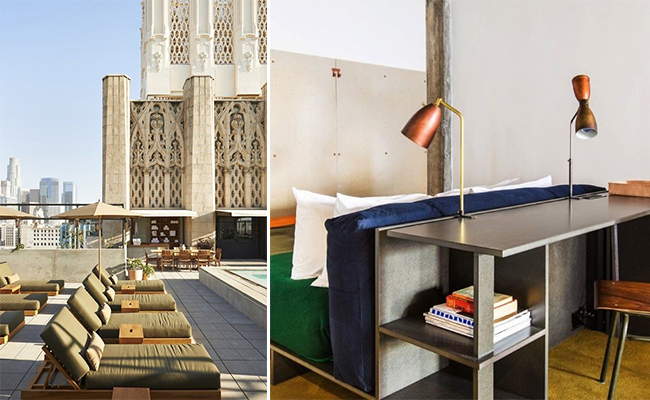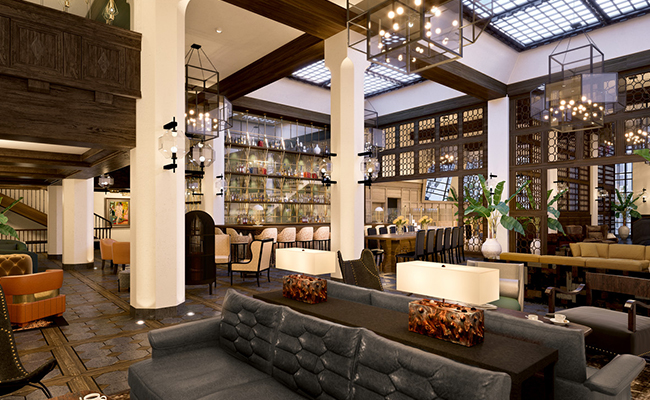Designing for Sincerity: Top Takeaways from ILCongress
Since 2013, the Independent Lodging Congress has united leaders and visionaries in independent hospitality development for a two-day conference of masterminding and collaboration. This year, the ILC was held on October 16-17 in Los Angeles at the Hotel Figueroa, Hoxton, and Ace Hotel Theatre, where attendees gathered to engage with industry professionals and learn about innovative strategies for the future of hospitality.
Historically, the ILCongress is a place for attendees and speakers to “disrupt” conventional hospitality and generate fresh concepts for experiential design. This most recent ILCongress gathering encouraged attendees to face the hard questions and ignite fierce conversations for actionable change. [If you know me, this is exactly the kind of gathering where I want to be!] –Marc DeSmet, Associate Principal
The flight from Vermont to Los Angeles felt akin to time travel. I boarded the plane in Burlington on a cool October afternoon and arrived in the later hours of the night to the urban machine of downtown LA, feeling the delirium of time change heavy on my eyelids. I took a cab—yes, a classic yellow Taxi Cab—from the airport to Downtown LA, and witnessed the enormity of the city: the sprawl of highways, the hovering mountains in the distance, the dissonant screech of traffic… it’s not the dreamscape Hollywood you might envision, but rather the honest grit and bustle of urbanism.

I arrived at the Ace Hotel, where the Day Two sessions would be held, and was enticed by its unique exterior: a blend of grandeur and modesty. Located in the heart of LA’s historic theatre district, the Ace Hotel is a former theatre building that re-opened in 2014 as a boutique hotel with a restaurant, three bars, and restored theatre. The style is Spanish Gothic and was modeled after the Segovia Cathedral.
Despite its iconic history and contemporary status as a hot spot for celebrities, politicians, and musicians, the Ace Hotel has a quiet and unassuming hip scene with equally unpretentious rooms. Think: couture dorm room. My bed resembled a futon (but much more comfortable) and was styled with a simple yet vibrant color-block blanket. Every detail of the fixtures in my room showcased its purpose, from the acoustic paneling to the leather washers spaced every 12 inches on the paneling. Minimal, detailed, and functional…clearly design was not an afterthought here!
DAY ONE
The first day of the conference was comprised of roundtable discussions at Hotel Figueroa and breakout sessions at the Hoxton Hotel. The hospitality and design professionals I encountered emerged as a collage—familiar faces from past ILC gatherings, old friends from previous jobs, and many new people with fresh experiences to share.
The design of public spaces in hotels, specifically lobbies, was a focus of a powerful discussion during one of the breakout sessions. Some questions we addressed during the session included: What is the purpose of a lobby in the context of a community? How do you foster a dynamic social environment through design? We talked about lobbies as momentary communities, welcoming spaces that reflect the locale of a place for visitors to create experiences with guests and locals alike.

I met David Neupert, the owner of Gold-Diggers, formerly a strip club and now an equal-parts bar, music venue, boutique hotel, and recording studio in East Hollywood. The 10-room, micro-hotel at Gold-Diggers means a unique lobby. This called into question: what is the right scale of a lobby? How does scale effect functionality, mood, and purpose? How does a smaller, intimate lobby influence the guest experience and accessibility for locals? How does a grand lobby create opportunities for engagement and connection with less intimacy?
Our discussions, open-ended questions, and individual experiences accumulated to this: lobbies are destinations and curated environments that foster the ability for people to connect in a different way every time they inhabit the space. Lobbies are changing to become multi-functional gathering spaces that, at the end of the day, broaden or enrich who you are from the moment you arrive to your departure.
DAY TWO
Day Two brought a captivating presentation on how design intersects with staff. An underlying theme at ILCongress 2019 talked about how the functionality, mood, and aesthetic of a brand is directly reflected through the choreography and “casting” of staff. If these components of a brand are not being curated with intention and purpose, the brand is not living up to all it can be.
As a designer, I think a company’s dress code should have enough options for employees to be comfortable and express their personal style while creating unity among the team and nodding to the affinity of a brand. When I traveled to Italy in September, I went to a bar where the mixologist’s uniform and accessories both complimented and enhanced the theatre of his craft. From the sound his bracelets made when moving the cocktail shaker to the position of his glasses perched at the end of his nose (so he could see both the concoction at hand as well as the guests he served), every detail of his uniform perfectly orchestrated his craftsmanship and my experience as a guest.

At ILCongress, we spoke of how staff who felt a comradery and identified with the lifestyle concept of the brand would have a longer commitment to their employment. Retaining employees being a better way to anchor a brands concept and deliver a sincere experience to guests; in lieu of trendy lifestyle photos on an Instagram page.
THE FOLLOWING DAYS AND WEEKS
The ILCongress always has a creative influence on me, hence why I keep going back! This year, from discussions of lobbies and communities to presentations on staff and culture, the real heart of my inspiration was to distinguish between authenticity and sincerity. What I came away with is: being “authentic” has become a bit of a buzz word in recent years. What I heard when I spoke to people about the goal of “authenticity”, was truly to be SINCERE. You can buy, stage, and choreograph authenticity with awareness of concept, place, and culture, but to take things to the next level, you need sincerity. Don’t just celebrate the authentic, but genuinely believe in it and design for it with all your heart.
Be Sincere.